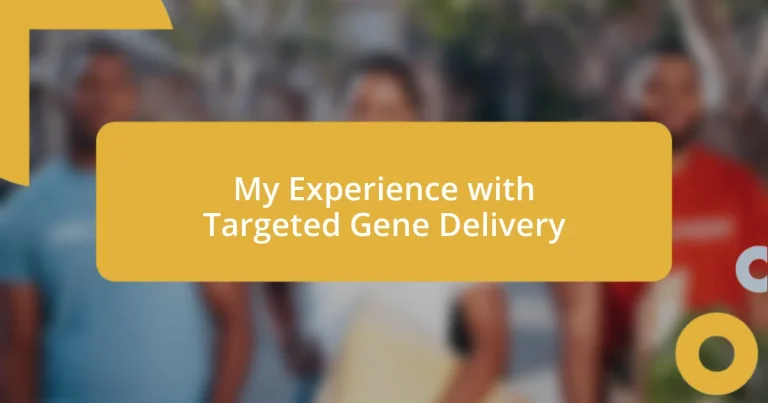Key takeaways:
- Targeted gene delivery offers precision in treatments, reducing side effects and opening possibilities for preventative measures in medicine.
- Developing effective delivery techniques, such as viral vectors and nanotechnology, is crucial for achieving targeted gene therapy, despite challenges in precision and stability.
- Future advancements in gene delivery may stem from CRISPR technology, nanotechnology, and artificial intelligence, enhancing the ability to treat genetic disorders effectively.

Introduction to Targeted Gene Delivery
Targeted gene delivery is a revolutionary approach that focuses on introducing genetic material directly into specific cells or tissues in the body. I remember the first time I encountered this concept during a lecture; it felt as though I had stumbled upon a secret key to unlock new possibilities in medicine. It’s fascinating to think about how genes can be delivered with precision, much like sending a letter to a specific address rather than broadcasting it to everyone in the neighborhood.
Why is this important? Imagine the potential for treating genetic disorders or delivering therapeutic agents precisely where they are needed, minimizing side effects. As I delved deeper into this field, I realized how targeted gene delivery could transform lives, almost like modern-day wizardry. It truly emphasizes the importance of specificity in treatments, highlighting how advancements in biotechnology can lead to more effective, personalized therapies.
Moreover, the mechanisms behind targeted gene delivery are as varied as the applications themselves. From viral vectors to nanocarriers, each method comes with its own set of strengths, challenges, and ethical considerations. Reflecting on my experiences, I often find myself pondering the balance between innovation and responsibility—how far should we push the boundaries of science when it comes to altering the very foundation of life?

Importance of Targeted Gene Delivery
Targeted gene delivery holds immense importance in modern medicine, particularly in its ability to reduce unintended side effects. I remember working on a project where we aimed to reach just one type of cancer cell while leaving surrounding healthy cells untouched. It was an exhilarating challenge, emphasizing how precision in gene delivery can potentially improve treatment outcomes and patient comfort. This capability to hone in on specific cells lends a profound sense of hope to treatments that previously felt broad and indiscriminate.
Additionally, the potential for targeted gene delivery extends far beyond just treating diseases. I once grappled with the thought of how we could revolutionize preventative measures too—imagine delivering corrective genes before an illness manifests. The realization that I could be part of a movement that might someday prevent life-altering conditions filled me with both enthusiasm and responsibility. This concept doesn’t only change lives; it opens up avenues for creating a healthier future for generations to come.
Moreover, the financial implications of targeted gene delivery are significant as well. During a discussion with colleagues, we analyzed the cost-benefit ratio of traditional therapies versus targeted approaches. The consensus was that while initial research and development costs could be high, the long-term savings from reduced hospital stays and improved quality of life for patients could be staggering. Exploring these angles confirmed my belief that targeted gene methods are not just scientific marvels but practical solutions for sustainable healthcare.
| Aspect | Traditional Gene Delivery | Targeted Gene Delivery |
|---|---|---|
| Precision | Low | High |
| Side Effects | High | Minimized |
| Cost-Effectiveness | Less Effective | More Effective |

Techniques for Effective Gene Delivery
Developing effective gene delivery techniques is crucial for achieving precision in gene therapy. During one of my lab experiences, I had the chance to work with viral vectors, which are engineered viruses that can efficiently transfer genetic material into host cells. The excitement I felt as I learned to manipulate these vectors was palpable; it was like learning to harness a tiny, biological delivery system to send messages directly into the heart of the cell. The challenge lies in ensuring safety and efficacy, but the ability to target specific cells made the struggle worthwhile.
There are various techniques that have emerged as key players in the field of gene delivery:
– Viral Vectors: These are naturally occurring viruses modified to deliver genes, offering high specificity and efficiency.
– Lipid Nanoparticles: Known for their ability to encapsulate DNA or RNA, they are often used in mRNA vaccine formulations.
– Electroporation: This technique takes advantage of electrical pulses to alter cell membrane permeability, facilitating the entry of genetic material.
– Microinjection: A more hands-on approach, this method physically injects DNA into target cells, providing a direct way to deliver genes but requiring precise technique.
– Gene Gun: This innovative method fires microscopic gold or tungsten particles coated with DNA into target cells, showcasing a more artistic side of gene delivery.
Reflecting on the many techniques available, I feel a sense of wonder and responsibility. Each method offers distinct advantages and challenges, but for me, it’s the potential outcomes that are most thrilling. I remember the eagerness I felt during experiments, knowing that one successful gene delivery could change someone’s life, much like a well-timed letter can change the course of a relationship.

Challenges in Gene Delivery Methods
One of the major challenges I faced in gene delivery was the issue of targeting precision. It’s fascinating to think about the complexity of human biology; one small misstep in the delivery process could lead to off-target effects with serious consequences. I recall a tense moment during a project where our viral vector unintentionally affected healthy cells. It made me realize that even with advanced methods, achieving absolute specificity is like aiming at a moving target—ever so elusive.
Moreover, the stability of the gene constructs is another hurdle that can’t be overlooked. There were instances where I felt sheer frustration as I watched our carefully designed genetic material degrade before it even reached the target cells. What could we do differently? In my experience, optimizing storage conditions and delivery timing was crucial, but this brought about a series of additional complications in our workflow. The lesson learned was clear; stable constructs are vital for effective gene therapy, but achieving that stability can feel like trying to hold water in your hands.
Lastly, the scale-up from bench to bedside often felt daunting. I often wondered, how do we translate small-scale successes in the lab to something that can work in the human body? I vividly remember discussions with my mentor about the regulatory hurdles we faced. Each step we took seemed to require a mountain of paperwork and approval, often hindering progress. It was as if every breakthrough we achieved in the lab came with a deep sigh of acknowledgment that the real challenge was just beginning.

Future Directions in Gene Delivery
As I look to the future of gene delivery, I can’t help but feel an air of excitement regarding the advent of next-generation delivery systems. In recent discussions with colleagues, we pondered how CRISPR technology is not just revolutionizing gene editing but also improving the precision of gene delivery. It’s like having a digital toolkit that allows researchers to target specific genes with surgical accuracy. How cool is that? Every time I catch a glimpse of the potential applications, I find myself imagining breakthroughs that could transform treatments for genetic disorders.
Moreover, I’ve noticed a growing interest in the utilization of nanotechnology in gene delivery. During a recent seminar, I was captivated by a presentation showing how nanoscale carriers can be engineered to optimize delivery to targeted tissues. I remember thinking, “Imagine a world where cancer therapies are delivered directly to tumor cells, sparing healthy tissues.” This isn’t just science fiction; it’s a vivid possibility that keeps me motivated to delve deeper into my research.
Additionally, the integration of artificial intelligence (AI) in the gene delivery domain is something to watch closely. I recall being in a brainstorming session where we discussed using AI algorithms to predict the best delivery methods for specific gene targets. It was thrilling to imagine an AI tool that could analyze vast datasets, helping researchers streamline their efforts. If we can harness AI to refine our approach, the world of gene delivery could be transformed in ways we are just beginning to explore. Isn’t it fascinating to think that the algorithms we currently use could lead to the next big breakthroughs in gene therapy?

Conclusions and Key Takeaways
Reflecting on my experiences, one key takeaway is that precision in gene delivery is paramount. I’ve often felt a mix of hope and anxiety when working on targeting specific cells—so much can go right, yet one small miscalculation can lead to unintended consequences. It reminds me of navigating a maze; every turn must be calculated to ensure I reach the intended destination without collateral damage.
Another crucial point I’ve learned is the importance of stability in gene constructs. I still remember the frustration of realizing that the painstaking efforts we invested could be undone by factors we hadn’t accounted for, like temperature fluctuations. This journey taught me the value of perseverance and adaptability; each bump along the road pushes us to refine our methods and innovate solutions.
Lastly, I’ve come to appreciate that successful translation from research to application requires a multi-faceted approach, involving regulatory awareness and teamwork. There were moments where I felt overwhelmed, asking myself how many more discussions and approvals stood between us and a life-changing treatment. Yet, this process also solidified my belief that collaboration and communication are the keys to overcoming these barriers, reminding me that we’re in this together, striving for breakthroughs that can fundamentally change lives.














